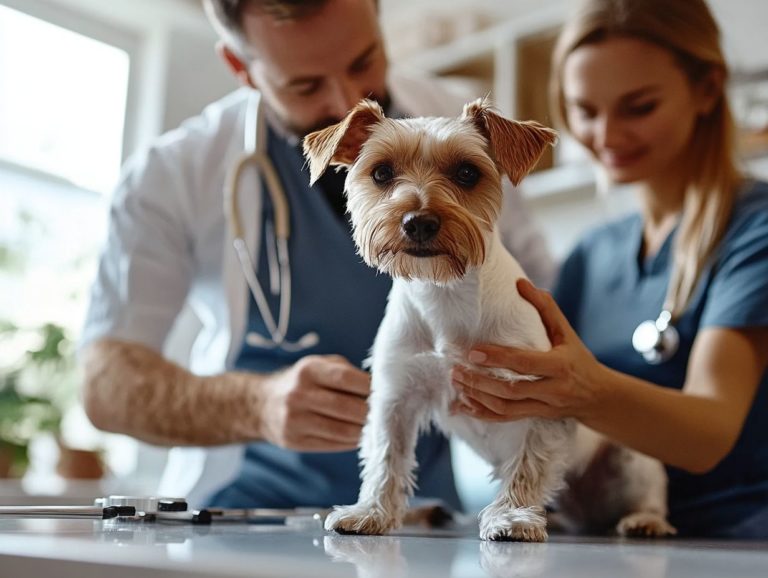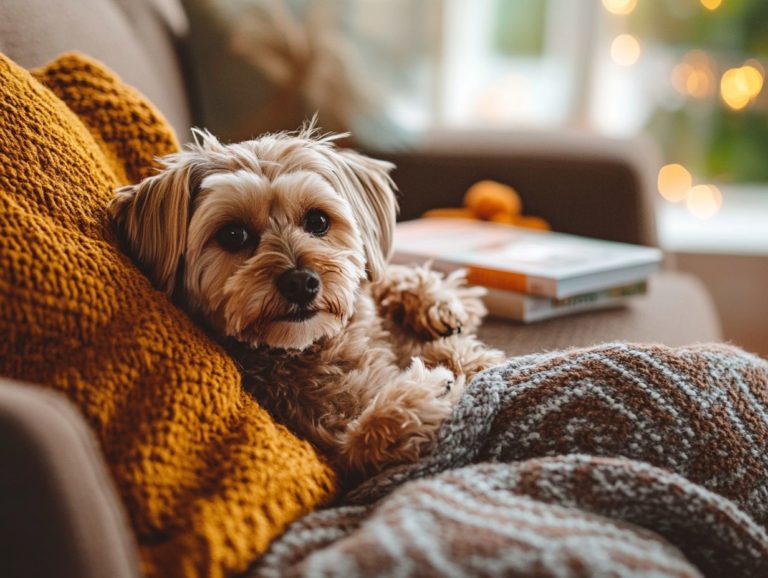How to Seek Help for Your Anxious Pet
Pet anxiety is a common yet often misunderstood issue that many furry companions face. Recognizing the causes and triggers is your first step in understanding your pet s behavior.
This guide provides essential insights into managing pet anxiety, covering signs and symptoms, treatment options, and knowing when to seek professional help.
Learn how to create a calming environment at home. Discover proactive strategies to prevent anxiety before it begins. Let’s work together to help your furry friend feel safe and sound!
Contents
- Key Takeaways:
- Understanding Pet Anxiety
- Signs and Symptoms of Pet Anxiety
- Seeking Professional Help for Your Pet
- Treatment Options for Pet Anxiety
- Supporting Your Anxious Pet at Home
- Preventing and Managing Pet Anxiety
- Frequently Asked Questions
- What are some signs that my pet may be experiencing anxiety?
- How can I help my anxious pet at home?
- When should I seek professional help for my pet’s anxiety?
- What type of professional can help with my pet’s anxiety?
- What can I expect during a consultation with a veterinary behaviorist?
- Can medication help with my pet’s anxiety?
Key Takeaways:

- Anxious pets may display behavioral changes such as excessive licking, hiding, and aggression.
- If your pet shows signs of anxiety, consult a veterinarian or animal behaviorist for proper diagnosis and treatment.
- Creating a calming environment, providing supportive care, and implementing preventative measures can help manage pet anxiety.
Understanding Pet Anxiety
Pet anxiety is a multifaceted emotional and behavioral challenge that can impact dogs of any age or breed. It often stems from a variety of underlying causes, including separation anxiety, fear-related anxiety, or confusion or memory problems in older dogs.
Understanding these factors is essential for dog owners who wish to offer effective ways to help reduce anxiety. By identifying specific triggers and leveraging veterinary resources, you can enable your furry companion to lead a calmer life by understanding anxious behaviors in pets and addressing their needs for a more balanced existence.
Causes and Triggers
Understanding the causes and triggers of pet anxiety is crucial for you as a dog owner seeking effective treatment strategies. This insight reveals specific issues, like separation anxiety, often linked to changes in routine when you leave for work or travel.
Fear-related anxiety is also common in dogs, who may react negatively to loud noises such as thunderstorms or fireworks. For older dogs, confusion or memory problems can further intensify feelings of disorientation and fear.
By recognizing these various triggers, you can tailor your approach to managing anxiety, whether through changing behavior or calming products. Resources like the Merck Veterinary Manual provide valuable information to enhance your understanding.
Signs and Symptoms of Pet Anxiety
Recognizing the signs and symptoms of pet anxiety is essential for effective intervention, as these manifestations can vary significantly among different dogs. You may notice common anxiety symptoms such as excessive barking or changes in eating habits.
It’s also important for you to familiarize yourself with canine body language. This can offer valuable insight into your pet’s emotional state, particularly when they encounter noise sensitivity or symptoms of cognitive dysfunction (CDS).
Identifying Behavioral Changes
Identifying behavioral changes in your dog is essential for recognizing symptoms of anxiety and crafting effective treatment plans. These changes can show up in various ways, such as noticeable withdrawal from social interactions or unexpected displays of aggression.
The onset of compulsive behaviors like excessive licking or tail chasing is also significant. Paying attention to canine body language is vital; subtle signs of discomfort like a stiff posture or tucked tail can signal deeper anxiety.
As a dog owner, it s your responsibility to understand these signals so you can effectively address your pet’s needs. By implementing positive reinforcement techniques or exploring changing behavior strategies, you can create a supportive environment that fosters calmness and trust.
Together, we can make a difference in your furry friend’s life! Start today!
Seeking Professional Help for Your Pet

If your dog shows ongoing anxiety symptoms, it’s crucial to seek help from a veterinarian or animal behaviorist. These experts can create personalized treatment plans that include behavior techniques and medications, as well as resources like understanding the needs of anxious pets.
Consulting professionals helps you understand your dog’s condition better. This ensures the right support tailored just for you.
When to Consult a Veterinarian or Animal Behaviorist
Knowing when to get professional help can make a big difference. Look for severe behavioral issues like aggression or destruction that suggest deeper problems.
If your at-home strategies like increased exercise or calming supplements don’t help after a few weeks, it s time to reach out for guidance. Take health concerns seriously as well.
Symptoms like excessive barking, hiding, or loss of appetite can indicate anxiety is affecting your dog s well-being. Being proactive is key to ensuring your dog gets the support they need.
Treatment Options for Pet Anxiety
Finding treatment options for your pet’s anxiety is vital for their happiness. It can involve several strategies like behavior modification techniques, including desensitization and counterconditioning, and understanding the role of veterinary advice in managing pet anxiety.
You may also consider calming products like Adaptil or ThunderCloud. In some cases, medications prescribed by a veterinarian can be effective.
Medications, Therapy, and Other Approaches
Medications and therapy play a big role in managing anxiety. Learn about the various medications available, especially SSRIs, which can help reduce anxiety symptoms.
Explore therapeutic techniques like desensitization to help your pet adjust to their anxiety triggers. For more effective strategies, consider the importance of professional guidance in pet anxiety. Behavioral modification focuses on encouraging positive behaviors through rewards.
By combining these strategies with calming products and proper exercise, you can create a tailored plan for your furry friend, promoting a calmer environment for both of you.
Supporting Your Anxious Pet at Home
Helping your anxious pet at home is essential for their emotional well-being. While creating a calming environment with positive reinforcement and safe spaces is important, knowing when to consult a professional for pet anxiety can also make a significant difference.
Consider using soothing products like ThunderShirt or Rescue Remedy. Make sure your dog gets enough exercise and proper nutrition to improve their overall health.
Creating a Calming Environment

Creating a calming environment for your pet is crucial in alleviating anxiety symptoms and ensuring their overall comfort. This involves various methods and products, as well as understanding the role of veterinary professionals in pet anxiety, designed to soothe their nerves and instill a sense of security.
Try playing soothing music for your pet it can work wonders! Establishing safe areas where your pet can retreat, like cozy corners or enclosed beds, provides a comforting haven during stressful times.
Utilizing training that rewards good behavior is another effective strategy, as it fosters a sense of confidence in your pet. Products like special clothing that gently hugs your pet and devices that release calming scents can significantly help in reducing their stress levels.
Don t underestimate the importance of regular exercise and a balanced diet. They are vital in maintaining your pet s mental health, allowing them to expend energy and remain balanced in both body and mind.
Preventing and Managing Pet Anxiety
Preventing and managing pet anxiety is crucial for dog owners dedicated to enhancing their pets’ emotional and physical well-being. You can employ effective anxiety prevention strategies by using consistent training techniques, ensuring your dog enjoys regular exercise and proper nutrition, and maintaining a stable environment to address potential behavior issues before they surface.
By prioritizing these proactive measures, you’ll significantly elevate your dog’s quality of life and reduce the chances of anxiety disorders developing in the long run.
Preventative Measures and Coping Strategies
Using preventive measures and coping strategies is vital to help dogs feel less anxious and create a nurturing environment.
Incorporating specific training techniques like socialization and gradual exposure to various stimuli can effectively alleviate your dog’s anxiety symptoms. Engaging in positive experiences during walks, playdates with other dogs, or park visits helps your dog build confidence and adaptability.
Equipping yourself with coping techniques, such as maintaining consistent routines and practicing relaxation exercises, will support both you and your furry friend during stressful times. Understanding your dog’s needs and cues fosters a sense of comfort that makes managing anxiety more holistic and effective.
Frequently Asked Questions
What are some signs that my pet may be experiencing anxiety?
Some common signs of anxiety in pets include excessive panting, pacing, whining, trembling, destructive behavior, and avoidance of certain situations or people.
How can I help my anxious pet at home?

There are several things you can do to help your pet at home, such as creating a safe and quiet space for them, providing plenty of exercise and mental stimulation, and using calming aids like essential oils or music designed for pets.
When should I seek professional help for my pet’s anxiety?
If your pet’s anxiety significantly impacts their daily life and causes distress for both you and your pet, it may be time to seek expert help for anxiety. This is especially important if your pet’s anxiety leads to behaviors that could harm themselves or others.
What type of professional can help with my pet’s anxiety?
A veterinary behaviorist or a certified animal behaviorist are specialized professionals who can provide expert guidance and treatment for your pet’s anxiety. To identify signs your pet needs help with anxiety, your regular veterinarian may also refer you to a qualified behaviorist.
What can I expect during a consultation with a veterinary behaviorist?
During a consultation, the behaviorist will gather information about your pet’s history, observe their behavior, and conduct any necessary tests to rule out underlying medical issues. They will then create a personalized treatment plan for your pet’s specific needs.
Start creating a calming environment for your furry friend today!
Can medication help with my pet’s anxiety?
Sometimes, medication is recommended to help with your pet’s anxiety. This is often part of a full treatment plan.
Work closely with your veterinarian. Always follow their instructions when giving medication to your pet.
If you’re concerned about your pet’s anxiety, don’t hesitate to consult your veterinarian. They’re here to help you find the best solution!






